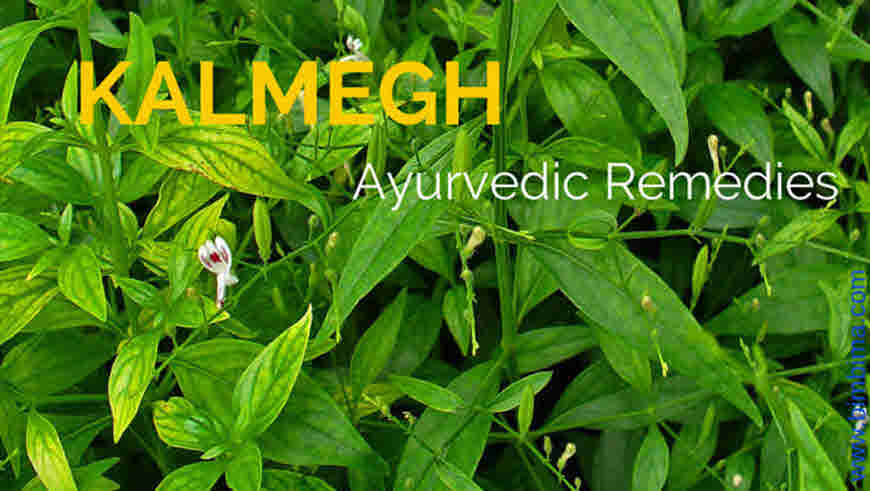Kalmegh (Andrographis paniculata) is bitter tonic and is useful in treating fever, the liver disorders, worms, abdominal gas and constipation. Kalmegh has antipyretic (lowers fevers), anti-inflammatory, antibacterial, antioxidant, antiparasitic and hepatoprotective (the liver proteccting) activities. It can also be used to treat children suffering from the liver and digestive system related problems.

Overview
Kalmegh is a very important medicinal plant of traditional medicine system. It is used in Ayurveda, Siddha, Unani and Homeopathy to treat broad variety of diseases. It is found growing wild throughout the plains and hills of tropical India, from Uttar Pradesh to Kerala, and also in Bangladesh, Pakistan and all South East Asian countries. It is cultivated as an ornamental garden plant. All part of the plant are extremely bitter due to which plant is known as king of bitter. This plant is called Hempedu Bumi (meaning bile of earth) in Malaysia.
This medicinal herb effectively treats all type of fevers. It is also indicated in the treatment of the liver diseases and jaundice. It has antiviral and the liver protecting action.
Kalmegh Information
- Classification of Andrographis Paniculata or Kalmegh
- Kingdom: Plantae
- Order: Lamiales
- Family: Acanthaceae
- Genus: Andrographis
- Species: A.paniculata
- Botanical name: Andrographis paniculata;synonym Syn: Justicia paniculata Burm.
Vernacular names
- Sanskrit: Kirata
- Indian name: Bhunimba, Yavatikta, Kalamegha, Kirata
- English name: Kriate, Kariyat, Creat
- Bengali name: Alui
- Gujrati: Lilun kariyatun
- Telugu: Nelavemu
- Tamil: Nila vembu
- Marathi: Olikiryata
- Ayurvedic: Kalmegha, Bhunimba, Bhumi nimbak, Vishwambhar, Yavtikta, Kalpanatha
- Unani: Kiryaat
- Siddha/Tami: Nilavembu
- Trade names: Kalmegh, Kirayat
- Chinese: Chuan xin lian
- Origin: Native to India and Sri Lanka
- Flowering and Fruiting of the plant: September-May
- Part used: Whole plant
- Dosage: Fresh juice 5-10 ml;Powder 1-3 grams;Decoction:50-100 ml
Description of Plant
Andrographis paniculata is erect plant with height of 30–110 cm. Its stem is slender dark green, squared in cross-section with longitudinal furrows and wings along the angles. The lance-shaped leaves have hairless blades measuring up to 8 centimeters long by 2.5 wide. The small flowers are borne in spreading racemes. The fruit is a capsule around 2 cm long and a few mm wide. It contains many yellow brown seeds.
Medicinal properties of Andrographis paniculata
- Antibacterial, antifungal
- Antiviral, antipyretic, adaptogenic, anti-inflammatory
- Improves immunity, Liver protecting
- Carminative, diuretic, gastric and the liver tonic
- Choleretic, hypoglycemic, hypocholesterolemic
- Bitter Tonic, Blood purifying
Traditional Uses of Andrographis paniculata
Kalmegh is extremely bitter medicinal herb useful in blood purification. In traditional medicine it is used for treating leprosy, gonorrhea, scabies, boils, skin eruptions, etc.due to its blood purification properties. Its decoction prevents and treats the liver diseases and fever.
The decoction/Kwath or infusion is also used in sluggish the liver, indigestion, bowel irregularity, anorexia, abdominal gas and diarrhea. Fresh leaf juice is given to prevent excessive bleeding during periods.
Whole plant is used in general debility, during convalescence after fevers. The plant is also useful for preventing and treating respiratory illness. Infusion of leaves is given in general weakness and indigestion.
How to use Kalmegh Andrographis paniculata for therapeutic use
1. Chronic fever : Kalmegh is an effective herb for treating chronic fever. Viral fever affects the liver badly. In such cases use of Kalmegh protects the liver and helps in faster recovery. For the medicinal purpose whole plant is used.
For treating chronic fever, or fever due to any reason, collect whole Kalmegh plant. Clean it and dry in shade. Prepare decoction by boiling 3-4 gm of it in glass of water till water reduces to one fourth. Drink this decoction twice a day. Since it is bitter in taste you may add misri or sugar.
2. Liver related problems, Infection in intestine : Kalmegh is especially useful in treating the liver related diseases. It exhibits hepatoprotective and hepatostimulative property. In traditional medicine system aqueous extract of Kalmegh leaves is given for jaundice. For treating the liver problems, jaundice, take leaves of Kalmegh (1 gm), Bhumi amla/Tamalki (1-2 gm powder), mulethi / liquorice (2 gm) in 200 ml water. Boil till water reduces to 50 ml. Then filter and drink.
3. Chronic constipation, Indigestion, abdominal gas : Take amla powder (2 gm), kalmegh (2 gm), mulethi (2 gm) and make decoction by boiling in 400 ml water till water reduces to 100 ml. Filter and drink.
4. Diarrhoea, gas and low appetite in children : Take leaves of kalmegh and cook in water till it thickens. Then add jaggery. When it cools down make small pills. Give these pills to children in diarrhea, gas and the liver related problems.
5. Skin problems : Kalmegh has blood purifying property. It removes toxins from blood and hence helps in the treatment of the skin diseases. For treating skin diseases, soak amla/Indian gooseberry (2 gm) and kalmegh (3 gm) in a glass of water at night. Next morning filter and drink.
Who should not use Andrographis paniculata
- Kalmegh is contraindicated in the following conditions:
- Bleeding disorders, hypotension, male and female sterility. It has shown anti-fertility effect in laboratory animals.
- Duodenal ulcers, hyperacidity, and oesophageal reflux.
- Pregnancy
This list is not complete, so use it cautiously. Take in recommended does as overdose can cause GI distress, anorexia, and emesis.
Is it possible to find this plant in Europe? Best regards